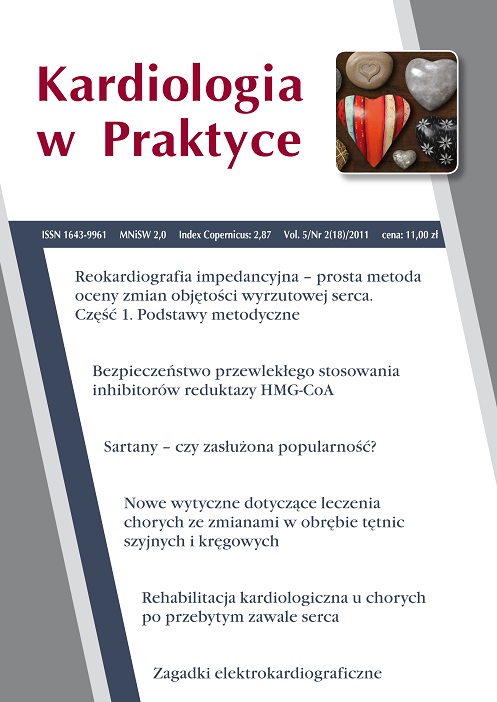Bezpieczeństwo przewlekłego stosowania inhibitorów reduktazy HMG-CoA Artykuł przeglądowy
##plugins.themes.bootstrap3.article.main##
Abstrakt
Statyny są jedną z najczęściej stosowanych grup leków. Badania kliniczne przeprowadzone w ostatnich latach dowiodły skuteczności inhibitorów reduktazy HMG-CoA we wtórnej i w pierwotnej prewencji incydentów sercowo-naczyniowych. Statyny charakteryzują się bardzo dobrą tolerancją, a ich długotrwałe stosowanie rzadko powoduje ciężkie działania niepożądane. Autorzy artykułu pokrótce omawiają dwa najcięższe działania niepożądane statyn – hepatotoksyczność oraz rabdomiolizę. Komentują także najnowsze dane dotyczące diabetogennego działania statyn oraz sugerowanego w przeszłości wzrostu ryzyka występowania chorób nowotworowych u osób stosujących inhibitory HMG-CoA.
Pobrania
##plugins.themes.bootstrap3.article.details##

Utwór dostępny jest na licencji Creative Commons Uznanie autorstwa – Użycie niekomercyjne – Bez utworów zależnych 4.0 Międzynarodowe.
Copyright: © Medical Education sp. z o.o. This is an Open Access article distributed under the terms of the Attribution-NonCommercial 4.0 International (CC BY-NC 4.0). License (https://creativecommons.org/licenses/by-nc/4.0/), allowing third parties to copy and redistribute the material in any medium or format and to remix, transform, and build upon the material, provided the original work is properly cited and states its license.
Address reprint requests to: Medical Education, Marcin Kuźma (marcin.kuzma@mededu.pl)
Bibliografia
2. Bryl W., Pupek-Musialik D.: Statyny: obecny stan wiedzy, rola w prewencji i terapii schorzeń układu sercowo-naczyniowego. Przew. Lek. 2006, 6: 98-105.
3. Wełnicki M., Mamcarz A.: Statyny w praktyce – pytania i odpowiedzi. Medical Education, Warszawa 2011.
4. Sattar N., Preiss D., Murray H.M. et al.: Statins and risk of incident diabetes: a collaborative meta-analysis of randomised statin trials. Lancet 2010 Feb 27; 375(9716): 735-42.
5. Hippisley-Cox J., Coupland C.: Unintended effects of statins in men and women in England and Wales: population based cohort study using the QResearch database. BMJ 2010 May 20; 340: c2197 [online: doi: 10.1136/bmj.c2197].
6. Mach T.: Statyny a ryzyko uszkodzenia wątroby. Przegląd Gastroenterologiczny 2007; 2(2): 111-115.
7. Denus S., Spinler S.A., Miller K. et al.: Statins and liver toxicity: a meta-analysis. Pharmacotherapy 2004; 24: 584-91.
8. Maddrey W.C.: Drug-induced liver disease: 2006. The risk profile of statins. American Association for the Study of the Liver Diseases. Annual Meeting, Boston, 2006.
9. Małecki R.: Rabdomioliza – postępowanie w warunkach opieki podstawowej. Kardiologia na co Dzień 2007, 2(2): 64-68.
10. Cannon C.P.: Balancing the benefits of statins versus a new risk-diabetes. Lancet 2010 Feb 27, 375(9716): 700-1 [online: DOI:10.1016/S0140-6736(09)60234-6].
11. Cholesterol Treatment Trialists’ (CTT) Collaborators. Efficacy and safety of cholesterol-lowering treatment: prospective metaanalysis of data from 90 056 participants in 14 randomised trials of statins. Lancet 2005, 366: 1267-78.
12. Shepherd J. et al.: Safety of Rosuvastatin: Update on 16,876 Rosuvastatin-Treated Patients in a Multinational Clinical Trial Program. Cardiology 2007, 107: 433-443.
13. Barylski M.: Rosuwastatyna. Biblioteka pisma „Cardiology Journal”. Via Medica, Gdańsk 2010.
